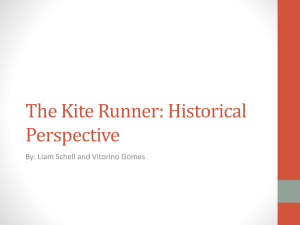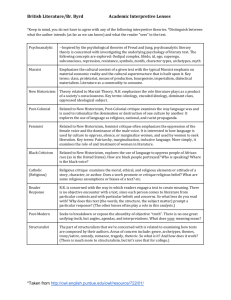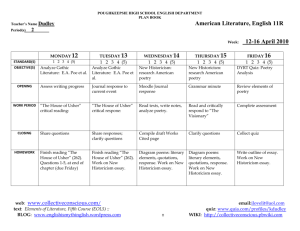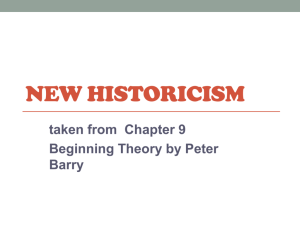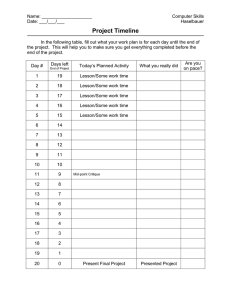Document 15349493
advertisement
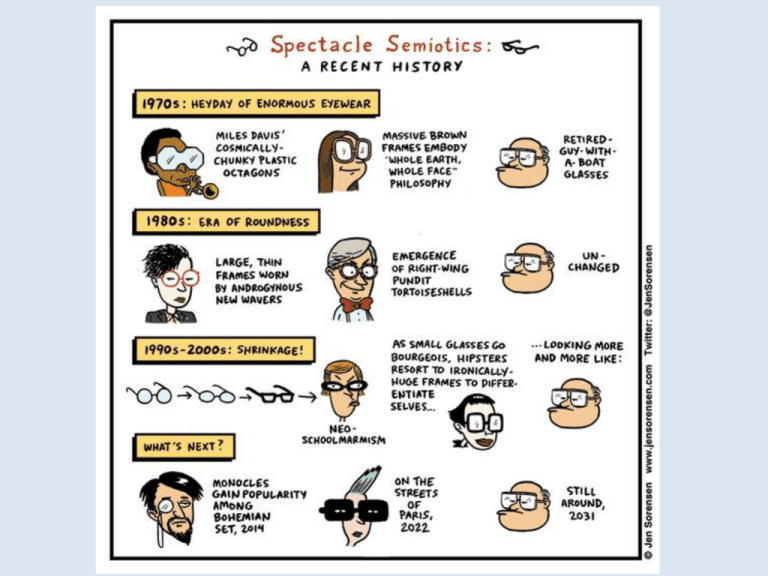
In the social production of their existence, men inevitably enter into definite relations, which are independent of their will, namely relations of production appropriate to a given stage in the development of their material forces of production. The totality of these relations of production constitutes the economic structure of society, the real foundation, on which arises a legal and political superstructure and to which correspond definite forms of social consciousness. The mode of production of material life conditions the general process of social, political and intellectual life. It is not the consciousness of men that determines their existence, but their social existence that determines their consciousness. Marx, Preface to A Contribution to the Critique of Political Economy (1859) The totality of these relations of production constitutes the economic structure of society, the real foundation, on which arises a legal and political superstructure and to which correspond definite forms of social consciousness. The mode of production of material life conditions the general process of social, political and intellectual life. Marx, Preface to A Contribution to the Critique of Political Economy (1859) The handmill gives you society with the feudal lord; the steam mill, society with the industrial capitalist. Marx, The Poverty of Philosophy (1847) What does it mean, “base determines superstructure”? • Base should determine superstructure ”vulgar Marxism,” Soviet realism (http://www.umsl.edu/~gradyf/theory/doones1.htm) • Base is reflected in superstructure Lukács & “totality” (praise of 19th c. Realist novels) • Base’s contradictions are exposed in superstructure Frankfurt School; Brecht; Benjamin (praise of Modernist texts) Althusser, from Ideology and Ideological State Apparatuses What are the ideological State apparatuses (ISAs)? They must not be confused with the (repressive) State Apparatus. Remember that in Marxist theory, the State Apparatus (SA) contains: the Government, the Administration, the Army, the Police, the Courts, the Prisons, etc., which constitute what I shall in future call the Repressive State Apparatus. Repressive suggests that the State Apparatus in question 'functions by violence'--at least ultimately (since repression, e.g. administrative repression, may take nonphysical forms). The Repressive State Apparatus in action: http://www.youtube.com/watch?v=GpwYGp4a0cQ&feature=related (2011) http://www.youtube.com/watch?v=6yXvQE9WJEY&feature=related (1968) Althusser, from Ideology and Ideological State Apparatuses I shall call Ideological State Apparatuses a certain number of realities which present themselves to the immediate observer in the form of distinct and specialized institutions. I propose an empirical list of these which will obviously have to be examined in detail, tested, corrected and reorganized. With all the reservations implied by this requirement, we can for the moment regard the following institutions as Ideological State Apparatuses (the order in which I have listed them has no particular significance): -the religious ISA (the system of the different Churches), -the educational ISA (the system of the different public and private 'Schools') , -the family ISA, -the legal ISA, -the political ISA (the political system, including the different Parties), -the trade-union ISA, -the communications ISA (press, radio and television, etc.), -the cultural ISA (Literature, the Arts, sports, etc.). Some “contradictions” ripe for symbolic resolution in narrative: What problem does the “New Historicism” seek to solve? The problem of History Some schools bracket it (structuralism, psychoanalysis, formalism, deconstruction) Some claim to stand outside—well, one: Marxism Some claim to understand it perfectly well (“old historicism”) http://winmedia.umsl.edu/gradyf/cathedral1.wmv In confronting the issue and following Frederic Jameson’s dictum—“Always historicize!”—it faces the problem of identity / difference: "If we choose to affirm the identity of the alien object with ourselves--if, in other words, we decide that Chaucer, say, or... the narratives of nineteenth-century Russian gentry are more or less directly or intuitively accessible to us with our own cultural moyens du bord--then we have presupposed in advance what was to have been demonstrated, and our apparent 'comprehension' of these alien texts must be haunted by the nagging suspicion that we have all the while remained locked on our own present ... that we have never really left home at all ... Yet, if as a result of such hyperbolic doubt, we decide to reverse this initial stance, and to affirm, instead and from the outset, the radical Difference of the alien object from ourselves, then at once the doors of comprehension begin to swing closed and we find ourselves separated by the whole density of our own culture from objects or cultures thus initially defined as Other from ourselves and thus as irremediably inaccessible." How does it attempt to solve this problem? • A return to local, contingent, localized, contested histories: Freed from static "world pictures," and faced with the opportunity to approach literary texts as agents as well as effects of cultural change, as participating in a cultural conversation rather than merely representing the conclusion reached in that conversation, as if it could have reached no other--at least partially freed from these tired habits and the collapsed assumptions on which they rested, we ought to be able to produce a criticism that would at least make significant strides toward understanding "language in history: that full field." Carolyn Porter, "Are We Being Historical Yet?" (1990) • A methodological self-consciousness and openness to self-examination (some would say, too much) Elements contributing to New Historicist practice: • Althusserian notions of ideology and subject formation • Foucault and discourse theory; how power works and creates subject-positions • Geertz’s cultural anthropology—interested in the symbolic functions of material practice, captured through “thick description,” snapshots of culture (n.b. thus a synchronic bias in its explanations) • The poststructuralist critique of representation, i.e., the deconstructive critique of language as a deferral of meaning, as a chain of signifiers, as productive of indeterminacy • Hayden White’s account of “the historical text as literary artifact”; cp. Montrose’s chiasmus: “the historicity of texts, the textuality of history.” A departure, it is claimed, from an “old historicism” • A methodological self-consciousness about the critic’s own historical situation and biases Elements contributing to New Historicist practice: • Althusserian notions of ideology and subject formation • Foucault and discourse theory; how power works and creates subject-positions “These collective social constructions on the one hand define the range of aesthetic possibilities within a given representational mode and, on the other, link that mode to the complex network of institutions, practices , and beliefs that constitute the culture as a whole.” (“Power of Forms,” 1445b) • Geertz’s cultural anthropology—interested in the symbolic functions of material practice, captured through “thick description,” snapshots of culture (n.b. thus a synchronic bias in its explanations) • The poststructuralist critique of representation, i.e., the deconstructive critique of language as a deferral of meaning, as a chain of signifiers, as productive of indeterminacy • Hayden White’s account of “the historical text as literary artifact”; cp. Montrose’s chiasmus: “the historicity of texts, the textuality of history.” A departure, it is claimed, from an “old historicism” • A methodological self-consciousness about the critic’s own historical situation and biases Elements contributing to New Historicist practice: • Althusserian notions of ideology and subject formation • Foucault and discourse theory; how power works and creates subject-positions • Geertz’s cultural anthropology—interested in the symbolic functions of material practice, captured through “thick description,” snapshots of culture (n.b. thus a synchronic bias in its explanations) “The critical practice…challenges the assumptions that guarantee a secure distinction between ‘literary foreground’ and ‘political background,’ or, more generally, between artistic production and other kinds of social production.” (1445b) • The poststructuralist critique of representation, i.e., the deconstructive critique of language as a deferral of meaning, as a chain of signifiers, as productive of indeterminacy • Hayden White’s account of “the historical text as literary artifact”; cp. Montrose’s chiasmus: “the historicity of texts, the textuality of history.” A departure, it is claimed, from an “old historicism” • A methodological self-consciousness about the critic’s own historical situation and biases Elements contributing to New Historicist practice: • Althusserian notions of ideology and subject formation • Foucault and discourse theory; how power works and creates subject-positions • Geertz’s cultural anthropology—interested in the symbolic functions of material practice, captured through “thick description,” snapshots of culture (n.b. thus a synchronic bias in its explanations) • The poststructuralist critique of representation, i.e., the deconstructive critique of language as a deferral of meaning, as a chain of signifiers, as productive of indeterminacy “The new historicism erodes the firm ground of both criticism and literature.” (144b) • Hayden White’s account of “the historical text as literary artifact”; cp. Montrose’s chiasmus: “the historicity of texts, the textuality of history.” A departure, it is claimed, from an “old historicism” • A methodological self-consciousness about the critic’s own historical situation and biases Elements contributing to New Historicist practice: • Althusserian notions of ideology and subject formation • Foucault and discourse theory; how power works and creates subject-positions • Geertz’s cultural anthropology—interested in the symbolic functions of material practice, captured through “thick description,” snapshots of culture (n.b. thus a synchronic bias in its explanations) • The poststructuralist critique of representation, i.e., the deconstructive critique of language as a deferral of meaning, as a chain of signifiers, as productive of indeterminacy • Hayden White’s account of “the historical text as literary artifact”; cp. Montrose’s chiasmus: “the historicity of texts, the textuality of history.” A departure, it is claimed, from an “old historicism” “The earlier historicism tends to be monological…It is not thought to be the product of the historian’s interpretation, nor even of the particular interests of a given social group in conflict with other groups.” (1444b) • A methodological self-consciousness about the critic’s own historical situation and biases Elements contributing to New Historicist practice: • Althusserian notions of ideology and subject formation • Foucault and discourse theory; how power works and creates subject-positions • Geertz’s cultural anthropology—interested in the symbolic functions of material practice, captured through “thick description,” snapshots of culture (n.b. thus a synchronic bias in its explanations) • The poststructuralist critique of representation, i.e., the deconstructive critique of language as a deferral of meaning, as a chain of signifiers, as productive of indeterminacy • Hayden White’s account of “the historical text as literary artifact”; cp. Montrose’s chiasmus: “the historicity of texts, the textuality of history.” A departure, it is claimed, from an “old historicism” • A methodological self-consciousness about the critic’s own historical situation and biases • “It tends to ask questions about its own methodological assumptions and those of others..” (1445b) Critical responses to New Historicism • It’s not really that new. (Certainly medievalists tend to feel that way!) Critical responses to New Historicism • It’s not really that new. (Certainly medievalists tend to feel that way!) • It depends on a reductive use of Foucault’s containment / subversion model (which may reductive to begin with) Critical responses to New Historicism • It’s not really that new. (Certainly medievalists tend to feel that way!) • It depends on a reductive use of Foucault’s containment / subversion model (which may reductive to begin with) • Marxist response: for all its rhetorical radicalism, it’s quietist, antimaterialist, tends to ignore class (due to its synchronic bias), and overemphasizes the symbolic Critical responses to New Historicism • It’s not really that new. (Certainly medievalists tend to feel that way!) • It depends on a reductive use of Foucault’s containment / subversion model (which may reductive to begin with) • Marxist response: for all its rhetorical radicalism, it’s quietist, antimaterialist, tends to ignore class (due to its synchronic bias), and overemphasizes the symbolic • Feminist response: not only are women left out of the new history, but feminism is left out of the account of New Historicism’s rise Critical responses to New Historicism • It’s not really new. (Certainly medievalists tend to feel that way!) • It depends on a reductive use of Foucault’s containment / subversion model (which may reductive to begin with) • Marxist response: for all its rhetorical radicalism, it’s quietist, antimaterialist, tends to ignore class (due to its synchronic bias), and overemphasizes the symbolic • Feminist response: not only are women left out of the new history, but feminism is left out of the account of New Historicism’s rise • Incoherency vis-à-vis its historicist / poststructuralist synthesis—asserting wall-to-wall textuality is inconsistent with making specific evidence-based arguments (Fish calls this situation hopeless but not serious) Critical responses to New Historicism • It’s not really new. (Certainly medievalists tend to feel that way!) • It depends on a reductive use of Foucault’s containment / subversion model (which may reductive to begin with) • Marxist response: for all its rhetorical radicalism, it’s quietist, antimaterialist, tends to ignore class (due to its synchronic bias), and overemphasizes the symbolic • Feminist response: not only are women left out of the new history, but feminism is left out of the account of New Historicism’s rise • Incoherency vis-à-vis its historicist / poststructuralist synthesis—asserting wall-to-wall textuality is inconsistent with making specific evidence-based arguments (Fish calls this situation hopeless but not serious) • An annoyingly coy reluctance about what Raymond Williams would call “incorporation”
